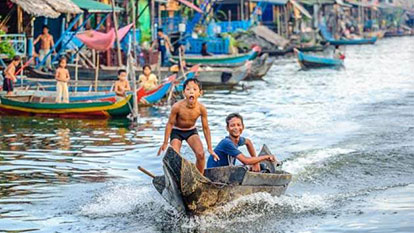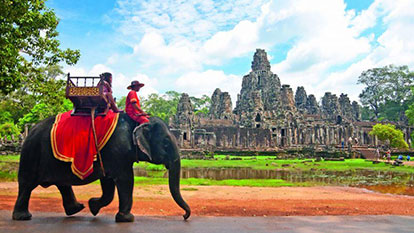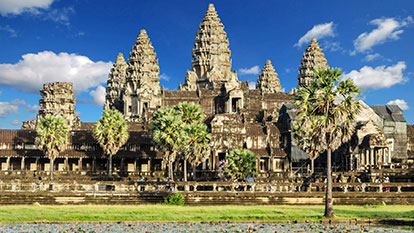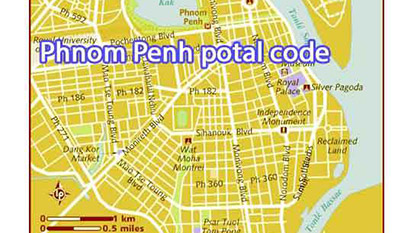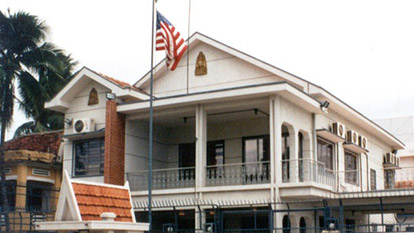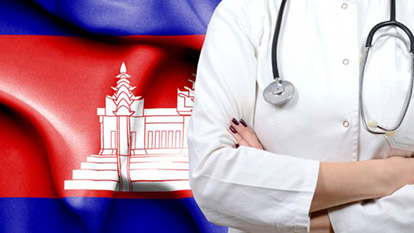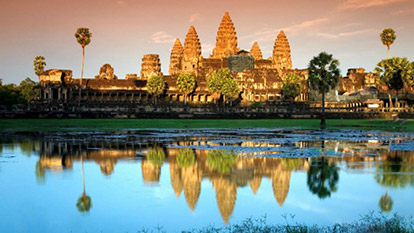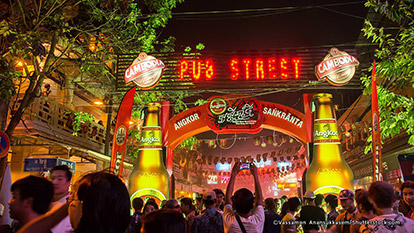Cambodia History
Early history
The first evidence of an advanced civilization in present-day Cambodia can be traced back to artificial circular earthworks estimated to date from the 1st millennium BC. By the 3rd to 5th centuries, the Indianised states of Funan and Chenla had emerged in what is now Cambodia and southwestern Vietnam. Most scholars believe these states were Khmer. For more than 2,000 years, Cambodia absorbed cultural influences from India and China, passing them on to other Southeast Asian civilizations such as Thailand, Vietnam, and Laos. The Khmer Empire, which flourished from the 9th to the 13th century, left a lasting mark on the region. Angkor, the empire's center of power, could have supported a population of up to one million people and was home to the famous Angkor Wat temple, a symbol of Cambodia's historical significance.
In the 13th century, Theravada Buddhism was introduced to Cambodia through monks from Sri Lanka, gradually becoming the dominant religion. Although the Khmer Empire began to decline, it remained a regional power until the 15th century. The empire faced many wars with neighboring kingdoms, and in 1432, Angkor was sacked by the Thai and abandoned due to ecological failure and infrastructure breakdown. The once-great city was overtaken by the jungle, leading to the myth of a lost civilization. The capital was moved to Lovek in an attempt to regain prosperity through maritime trade, but this effort was short-lived. Continued conflicts with the Thai and Vietnamese led to further territorial losses, and Lovek fell in 1594.
For the next three centuries, Cambodia alternated as a vassal state under the Thai and Vietnamese kings, with only brief periods of independence. Today, Angkor Wat and the ruins of Angkor serve as powerful reminders of Cambodia's rich history and cultural heritage. For travelers interested in exploring this fascinating past, the Cambodia travel guide offered by Galatourist can provide valuable insights and unforgettable experiences of the country’s historical landmarks.
Modernity and French Indochina
In 1863, King Norodom, who had been installed by Thailand, sought protection from France to escape the growing tensions with both the Thai and Vietnamese. By 1867, a treaty was signed between the Thai king and France, in which Thailand renounced its suzerainty over Cambodia in exchange for control of the Battambang and Siem Reap provinces. These provinces officially became part of Thailand but were returned to Cambodia in 1906 through a border treaty between France and Thailand.
Cambodia remained a French protectorate from 1863 to 1953, governed as part of French Indochina, although it was briefly occupied by Japan from 1941 to 1945. After King Norodom's death, France manipulated the royal succession and placed Norodom's brother, Sisowath, on the throne. Upon the death of Sisowath's son Monivong in 1941, France bypassed his heir, Monireth, fearing his independent nature, and enthroned Norodom Sihanouk, who was just eight years old, believing him to be easier to control. However, France underestimated Sihanouk, and under his reign, Cambodia gained independence from France on November 9, 1953.
Following independence, Cambodia became a constitutional monarchy under King Norodom Sihanouk. During this period, Cambodia officially lost control of the Mekong Delta, which was awarded to Vietnam, although the Vietnamese had governed the region since 1698, when King Chey Chettha II allowed Vietnamese settlers into the area. For travelers interested in learning more about this rich history, Cambodia travel tips from Galatourist can provide valuable insights into the country's royal and colonial past.
Independence and Cold War
After Cambodia gained independence from France in 1953, King Norodom Sihanouk played a significant role in shaping the nation’s political landscape. In 1955, he abdicated in favor of his father and was elected Prime Minister. After his father's death in 1960, Sihanouk became the head of state, adopting the title of Prince. During the Cold War, Sihanouk adopted a policy of neutrality as the Vietnam War intensified. However, this neutrality was short-lived, as tensions within Cambodia escalated. In 1970, while Sihanouk was abroad, he was ousted in a military coup led by Prime Minister Lon Nol, backed by the U.S. Sihanouk aligned himself with the Khmer Rouge, a communist faction, as they gained territory with support from China. His efforts to rally his followers contributed to the Cambodian Civil War.
Between 1969 and 1973, U.S. forces bombed Cambodia to target the Viet Cong and Khmer Rouge. This led to widespread displacement, and the war’s devastation only fueled the Khmer Rouge’s rise to power. By 1975, the Khmer Rouge, led by Pol Pot, took control of Phnom Penh, changing the country’s name to Democratic Kampuchea. Their brutal regime, which sought to return Cambodia to an agrarian society, led to the deaths of an estimated 1 to 3 million people through executions, forced labor, and starvation. Ethnic minorities, professionals, and intellectuals were heavily targeted.
In 1978, Vietnam invaded Cambodia, overthrowing the Khmer Rouge by early 1979. This ended the genocidal regime, but fighting between Khmer Rouge forces and Vietnamese-backed Cambodian forces persisted throughout the 1980s. Peace talks, which began in Paris, eventually led to the 1991 Paris Peace Agreement, paving the way for Cambodia’s recovery.
For those interested in exploring Cambodia’s turbulent history, especially regarding the Cold War and independence, Cambodia travel tips from Galatourist, a local agency in Cambodia, can offer insightful tours to historical sites that reflect the country’s past.
Reconstruction and Constitutional Monarchy
In recent years, Cambodia has made significant progress in reconstruction efforts, with political stability established under a Constitutional Monarchy, multiparty democracy, since 1993. However, the country’s natural resources, particularly its valuable timber, continue to be exploited by interests from countries such as Thailand, Vietnam, Malaysia, Singapore, and Australia. Until 1999, the Khmer Rouge remained active in some areas, often supporting illegal logging operations. At that time, traveling by land and river remained precarious.
Despite the stability following the conflict, Cambodia experienced a setback in 1997 due to a coup d’état, though peace has generally been maintained since then. The country has received substantial aid from nations like Japan, France, Germany, Canada, Australia, the United States, and the United Kingdom. As Thailand faces ongoing political turmoil, Cambodia is emerging as a regional alternative for business investments.
Cambodia is gradually moving beyond its war-torn past, focusing on national reconstruction. In recent years, the country has seen double-digit economic growth and is seeking foreign investment to modernize its economy and combat poverty. As a rising destination for investors and travelers alike, Cambodia tour operators, such as Galatourist, offer insights into Cambodia’s lifestyle and opportunities for exploring this evolving nation.
Sincerely yours & see you soon!
GALATOURIST since 2005.
Testimonials

Ms. Francesca Tronconi & Mr Vizzolini Davide (2pax) from Spain

Mrs & Mr. DUPUIS (2pax) from United States

Mr. Jeffrey Szymanski (2pax) from United States

Mrs Rosemary McGuinness (2pax) from Australia

Mrs Elena Maria Sanchez (2pax) from Spain

Group Marissa (4pax) from United States

Mr Jerzy (2pax) from Canada






